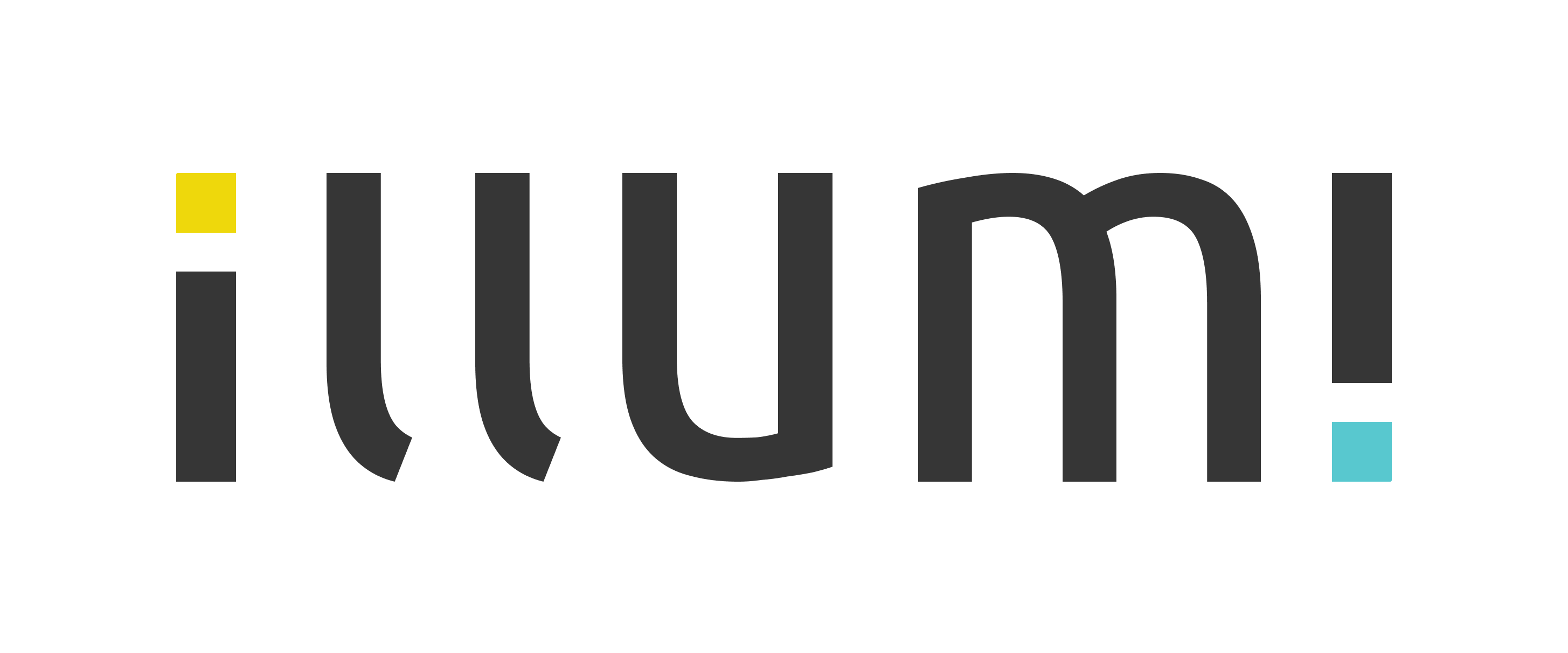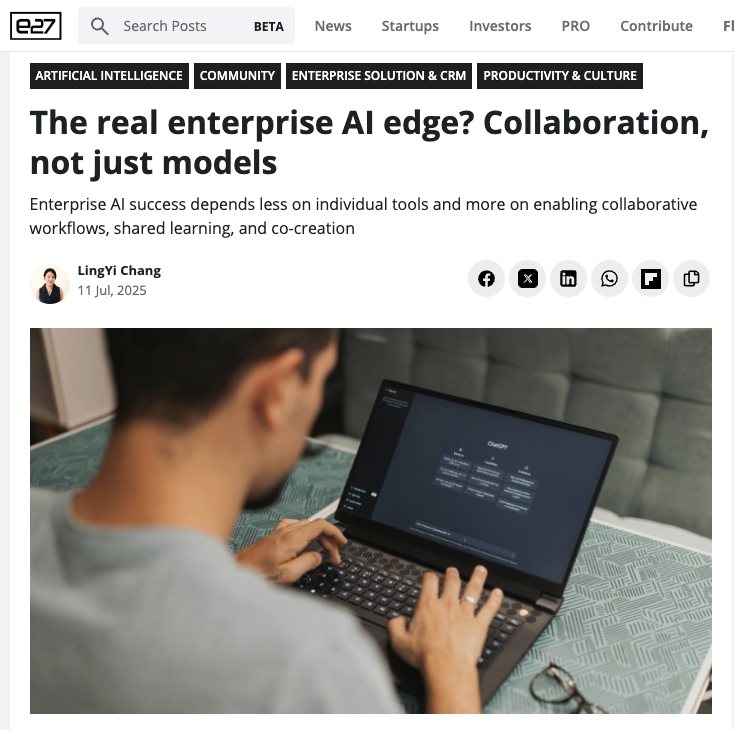在最近一場演講中,主持人問我:「ChatGPT 和類似工具在消費市場如此主流,那企業 AI 的真實狀況是什麼?」
這是個很及時的問題——答案看似簡單,實則複雜。你可以擁有世界上最好的 AI 模型,但如果沒有做好協作,仍然很難真正釋放企業價值。
為什麼協作對企業更重要
看看消費市場,個人用戶快速擁抱了 AI 驅動的聊天機器人和生產力工具。例如 ChatGPT,似乎一夜之間就獲得了數百萬用戶。這個故事講的是速度、便利和個人賦能。但企業的情況根本不同。當組織試圖在團隊中複製消費工具「英雄式的個人生產力」時,往往會碰壁。
為什麼?企業是複雜的生態系統。人們不是孤立工作,而是在結構化的團隊中運作,受流程管理,嵌入在經過多年——甚至幾十年——發展出來的文化中。在這種環境裡,成功很少由單打獨鬥的天才創造;而是由能夠適應、學習並建立在彼此進展之上的協作團隊所譜寫。
研究一致顯示,在企業轉型中,技術本身只佔專案成功因素的不到 30%。其餘超過 70% 取決於人、流程和文化。而這三者的核心,就是協作能力。
孤立 AI 工具的危險
老實說:現在最流行的 AI 工具本質上都很個人化。它們存在於我們的聊天視窗裡,回答我們的提示,幫我們起草只有自己看得到的電子郵件。雖然有幫助,但這種方式嚴格限制了 AI 的商業價值——只是許多小型、互不連結的改善的總和。
現在想像一下,如果每個新見解、提示詞或工作流程都被孤立在某個人的電腦裡。客服人員調整出一個能幫助幾十位同事的提示詞,銷售主管發現一個用 AI 助理在幾秒內完成競爭分析的方法——但這些知識從未離開他們的裝置。這種孤立的「AI 影子 IT」不僅限制了組織學習,也讓轉型動能停滯不前。
企業生產力的關鍵不是最快的個人,而是最能適應、最一致、最會協作的團隊。這就是 AI 有潛力成為倍增器的地方——但前提是我們把協作作為主要設計原則。
協作 AI 的優勢
AI 的力量不只在於分散使用,更在於協作運用時的複利效應。在 illumi 的工作中,我們看到四種帶來成功企業 AI 導入的模式:
AI 用於團隊知識,而非只是個人捷徑:當 AI 工具被設計來捕捉和改進集體知識——無論是精煉提示詞、分享最佳實踐,還是揭露常見盲點——組織就能建立隨時間強化的知識庫。
共同創造與實驗:創新在想法粗糙、草率、可供討論的地方蓬勃發展。當團隊被鼓勵提早迭代和分享他們的 AI 工作流程——即使「不完美」——每個人都能一起學習、適應和改進。根據我們自己的經驗,提早分享讓工作流程的改進速度比孤立作業快了兩到三倍。
AI 是促進者,不是專家:最好的 AI 驅動團隊不把工具當作神諭,而是當作跳板。成員們挑戰假設、公開測試假說,把 AI 建議當作起點——而非最終答案。這種開放的好奇文化帶來更大的認同、更快的學習循環,以及更少的「自動化盲點」風險。
透明的回饋循環:有效的企業 AI 平台會自動記錄什麼有用、什麼沒用。每個人都能從同事的錯誤、轉向和突破中受益。這種文化透明度讓組織更具適應力,這在快速變化的環境中是最寶貴的資產。
把協作放在企業 AI 的核心
如果你負責組織的 AI 或數位轉型,這是我最強烈的建議:不要只關注 AI 模型的精密度或使用者介面的美觀。相反地,問問自己:
- 你目前的做法是讓團隊容易一起實驗,還是鼓勵各自為政?
- AI 驅動的見解和工作流程容易在團隊間分享、調整和延伸嗎?
- 你的實施是否強化了共同創造的文化——「草稿」和「進行中的工作」是否像完善的報告一樣受到重視?
- 你衡量成功的標準是否不只是工具採用率,還包括團隊一起學習、迭代和改進的速度?
展望未來,我堅信下一波企業 AI 的贏家不會是那些單純選擇最好模型的人,而是那些為協作智能而設計的人。最創新的解決方案將來自多元思維建立在彼此實驗之上、質疑假設,並即時分享得來不易的經驗。
最後的想法:AI 是團隊運動
AI 在消費市場的進展既快速又令人印象深刻。但企業的故事才剛開始——而且不會只由 AI 單獨書寫。把協作放在 AI 策略的核心,你就能釋放組織最強大的資產:集體智慧。
問題不是你是否能使用 AI,而是你的團隊是否能一起工作、學習和進化。
At a recent talk, the host asked me: “With ChatGPT and similar tools so dominant in the consumer space, what’s the real story when it comes to enterprise AI?”
It’s a timely question—and one with a deceptively simple answer. You can have the best AI models in the world, but if you don’t get collaboration right, it will still be hard to unlock true enterprise value.
Why collaboration matters even more for enterprise
If we look at the consumer landscape, individuals have rapidly embraced AI-powered chatbots and productivity apps. ChatGPT, for example, landed millions of users seemingly overnight. The narrative is one of speed, convenience, and individual empowerment. But enterprise contexts are fundamentally different. When organisations attempt to replicate the “heroic solo productivity” of consumer tools within their teams, they often run into a wall.
Why? Enterprises are complex ecosystems. People don’t work in isolation but within structured teams, governed by processes, and embedded in cultures that have developed over years—if not decades. In this environment, success is rarely crafted by lone geniuses; it is composed by collaborative groups who can adapt, learn, and build on each other’s progress.
Research consistently shows that in enterprise transformation, technology alone accounts for less than 30 per cent of project success. The rest—over 70 per cent—depends on people, processes, and culture. And at the centre of all three is the ability to collaborate.
The dangers of isolated AI tools
Let’s be honest: today’s most popular AI tools are inherently personal. They sit in our chat windows, answer our prompts, and help us draft emails that only we see. While helpful, this approach tightly restricts AI’s business value to the sum of many small, disconnected improvements.
Now imagine if every new insights, prompt, or workflow lived in a silo on just one person’s desktop. A customer service rep tinkers with a prompt that could help dozens of colleagues. A sales leader discovers a way to get competitive analysis in seconds using an AI agent—but that knowledge never leaves their device. Such isolated “AI shadow IT” not only limits organisational learning but also stalls momentum for transformative change.
Enterprise productivity is not about the fastest individual, but the most adaptive, aligned, and collaborative teams. This is where AI has the potential to become a multiplier—but only if we make collaboration the main design principle.
The collaborative AI advantage
The power of AI compounds not just when it’s distributed, but when it’s collaboratively harnessed. In our work at illumi, we see four patterns that lead successful enterprise AI adoption:
- AI for team knowledge, not just personal shortcuts: When AI tools are built to capture and improve collective knowledge—whether that’s refining prompts, sharing best practices, or surfacing frequent blind spots—organisations build a knowledge base that strengthens over time.
- Co-creation and experimentation: Innovation thrives where ideas are rough, sketchy, and up for debate. When teams are encouraged to iterate and share their AI workflows early—even if they’re ‘imperfect’—everyone learns, adapts, and improves together. In our own experience, early sharing led to workflows that improved two or three times faster compared to approaches worked on in isolation.
- AI as a facilitator, not an expert: The best AI-driven teams don’t treat the tool as an oracle, but as a springboard. Their members challenge assumptions, test hypotheses out loud, and use AI suggestions as starting points—not final answers. This open culture of curiosity leads to greater buy-in, faster learning loops, and fewer risks of “automation blind spots.”
- Transparent feedback loops: Effective enterprise AI platforms log what works—and what doesn’t—automatically. Everyone benefits from seeing the mistakes, pivots, and breakthroughs of their colleagues. This cultural transparency makes the organisation much more adaptive, which is the ultimate asset in a rapidly changing landscape.
Putting collaboration at the heart of enterprise AI
If you’re responsible for AI or digital transformation in your organisation, here’s my strongest advice: Don’t focus solely on the sophistication of the AI model or the beauty of the user interface. Instead, ask yourself:
- Does your current approach make it easy for teams to experiment together, or does it encourage working in silos?
- Are AI-driven insights and workflows easy to share, adapt, and build upon across teams?
- Does your implementation reinforce a culture of co-creation—where “rough drafts” and “work-in-progress” are celebrated as much as polished reports?
- Is your success being measured not just by tool adoption rates, but by the rate at which teams learn, iterate, and improve together?
Looking ahead, I firmly believe the next wave of enterprise AI winners will not be those who simply choose the best model, but those who engineer for collaborative intelligence. The most innovative solutions will come from diverse minds building on each other’s experiments, questioning assumptions, and sharing hard-won lessons in real time.
Final thoughts: AI is a team sport
The advancement of AI in the consumer market has been fast and impressive. But the enterprise story is just beginning—and it will not be written by AI alone. By placing collaboration at the centre of your AI strategy, you unlock your organisation’s most powerful asset: its collective intelligence.
The question isn’t whether you have access to AI, but whether your teams are empowered to work, learn, and evolve—together.





